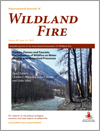International Journal of Wildland Fire
Volume 28
Number 10 2019
Forests, Flames and Faucets: the Influence of Wildfire on Water Quality and Watershed Processes
The papers in this special issue focus on the impacts of wildfire on factors that regulate streamflow, water quality, sediment transport, and aquatic habitats. Despite decades of watershed research, our understanding of the effects of wildfires on the processes that regulate clean water supply remains limited. Key challenges and research needs are summarised and the contribution each paper makes to improve understanding of wildfire impacts is evaluated. Research priorities aimed at improving our ability to predict wildfire impacts on watersheds are outlined.
Composition and toxicity of wildfire ash from six vegetation types, distributed globally, on the freshwater indicator species Daphnia magna were examined. Toxicity was significantly increased with higher pH, NO3− and Cl− content, whereas heavy metals or polycyclic aromatic hydrocarbon content did not play a significant role.
Long-term wildfire studies are rare; however, in combination with post-wildfire salvage logging, wildfire can have long-lasting impacts on stream ecosystems. We sampled aquatic macroinvertebrates from burned catchments 8 years after a severe wildfire. Differences in abundance and community composition showed that the effects of wildfire and salvage logging can be persistent.
Forest canopy interception can be significantly reduced after wildfire, allowing more precipitation to reach the forest floor. This study documents differences in net rainfall and snow accumulation between burned and unburned subalpine forest stands in the Canadian Rocky Mountains. The results suggest substantially higher net precipitation in burned stands during a 10-year period following a severe wildfire.
Post-fire rainstorms mobilise organic carbon produced by prescribed fire. An optical sensor allowed us to capture the dynamics of organic carbon release in post-fire storms.
This study examines physical, climatological, biological and soil characteristics of 153 fire-impacted watersheds to determine which watershed features are related to the type and duration of water quality response after fire. Our results demonstrate pre-fire soil characteristics, burn severity, and post-fire vegetation are associated with water quality impacts from wildfire.
We combined measures of fuel treatment effectiveness, feasibility and cost in a linear optimisation model to prioritise fuels reduction type and location to protect water supplies from fire-related sediment.
The long-term effects of forest management on water quality were investigated through parallel laboratory and field studies. The results suggest that long-term management practices such as prescribed fire, harvesting and understory mastication may alter detrital mass and chemistry in favour of improved source and drinking water quality, adding to the list of ecosystem benefits that active forest management may provide.
Post-wildfire soils are susceptible to erosion that may deplete the carbon and nitrogen stocks that are essential for ecosystem recovery. We monitored erosion of soil carbon and nitrogen after eight severe wildfires and compared losses between untreated slopes and those receiving erosion-mitigation treatments. Post-fire losses of soil carbon and nitrogen were strongly linked with total erosion rates and were reduced by erosion mitigation treatments.





